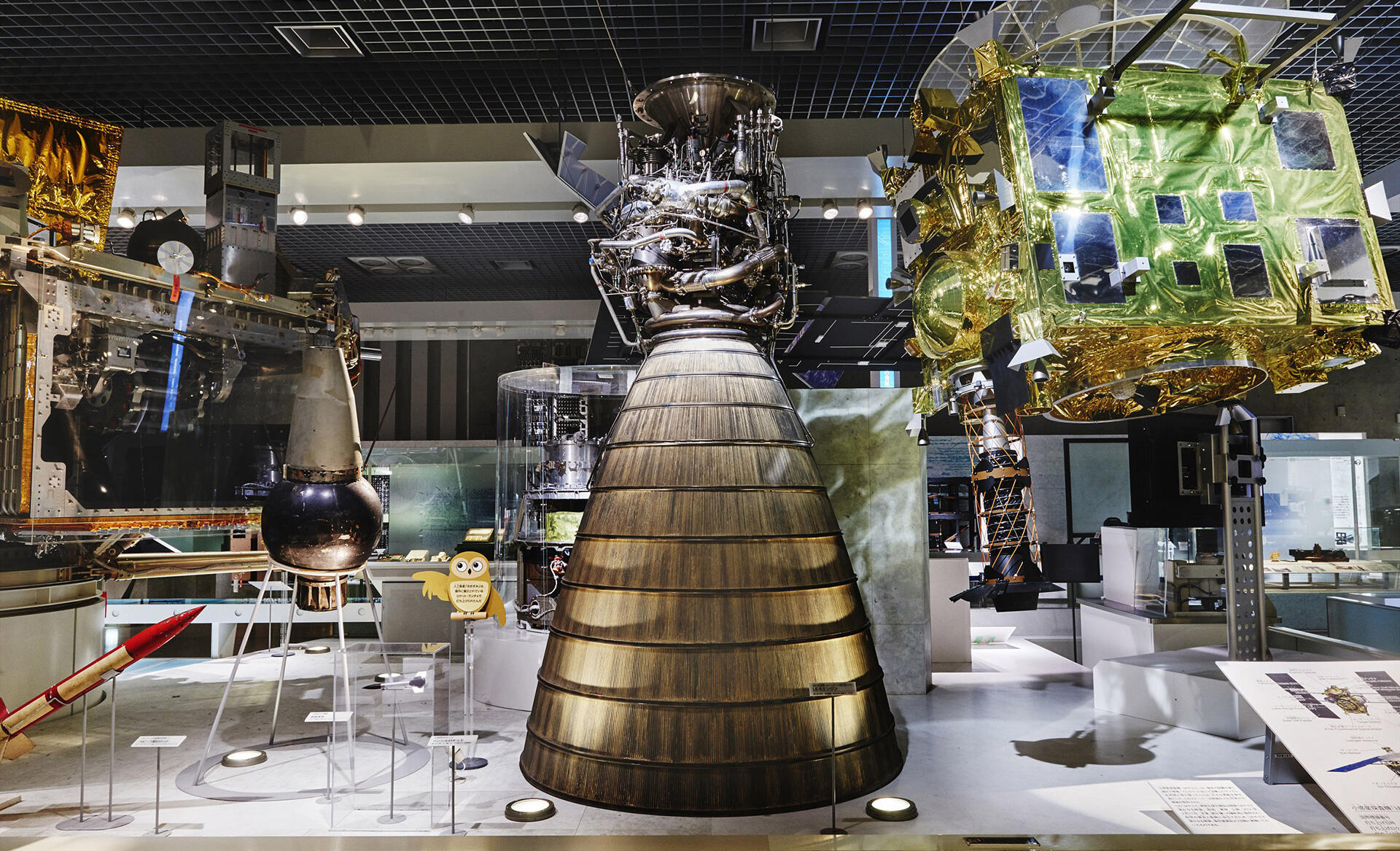
Special Talk: Stories in Nature and Science and Technology

Stories in Nature and
Science and Technology
HAYASHI Yoshihiro(Director General, National Museum of Nature and Science)
×
YAMAKAWA Hiroshi(President, JAXA)
The year 2020 marked the memorable 50thanniversary of the launching of Japan's first satellite, Ohsumi, from the Uchinoura Space Center in Kagoshima Prefecture. The National Museum of Nature and Science, Tokyo (hereinafter "the Science Museum") is the only comprehensive national museum devoted to science. Deepening people's awareness of the Earth, life and science and technology, while making a contribution to thinking about the ideal relationship between humans, nature and science and technology - the Science Museum's perspective intercrosses with that of JAXA.
The following is a dialog between YAMAKAWA Hiroshi, the President of JAXA, and HAYASHI Yoshihiro, the Director General of the Science Museum, which actually has deep links with JAXA through its exhibition of materials relating to Japan's rocket development and space research, as well as the hosting in February 2020 of an exhibition and symposium to mark the 50 years since the lunching of Ohsumi.
While looking at the relationship between nature and science and technology, the two experts examine what lies on the intersecting points of the two institutions.
Focusing on the countless stories of science
YAMAKAWA
I've heard that the Lecture Hall that was the venue for the February 2020 symposium on Ohsumi was also a place where the Antarctic explorer SHIRASE Nobu delivered a lecture.
HAYASHIi
Indeed, in the era that Shirase delivered his lecture (1936) the Museum was still known as "Tokyo Science Museum." It is now 143 years since the Museum was established in 1877, and we have been a familiar presence to people for a long time as the only comprehensive national museum for natural history and the history of science and technology.
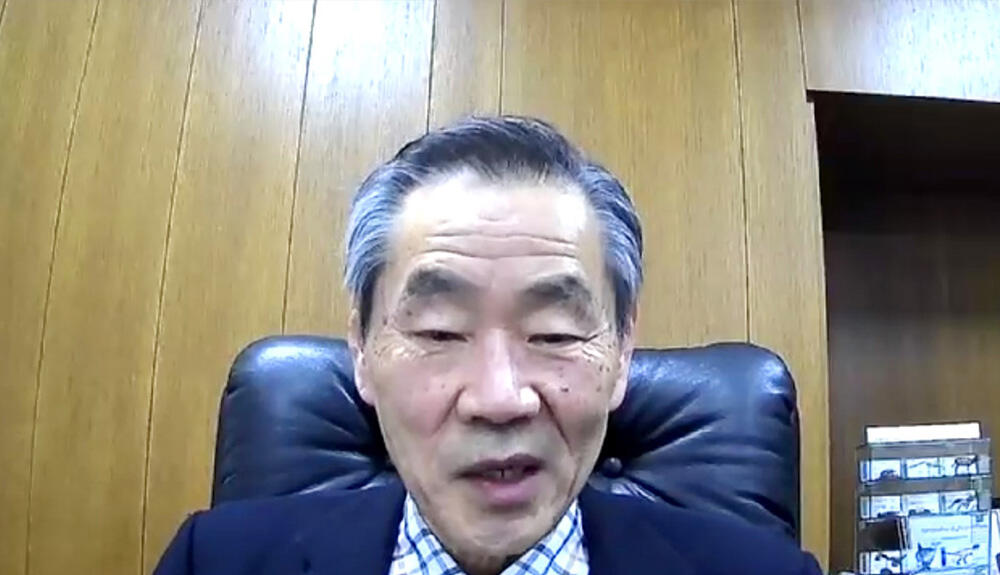
HAYASHI Yoshihiro, Director General, the National Museum of Nature and Science

YAMAKAWA Hiroshi, President, JAXA. The dialog took place online.
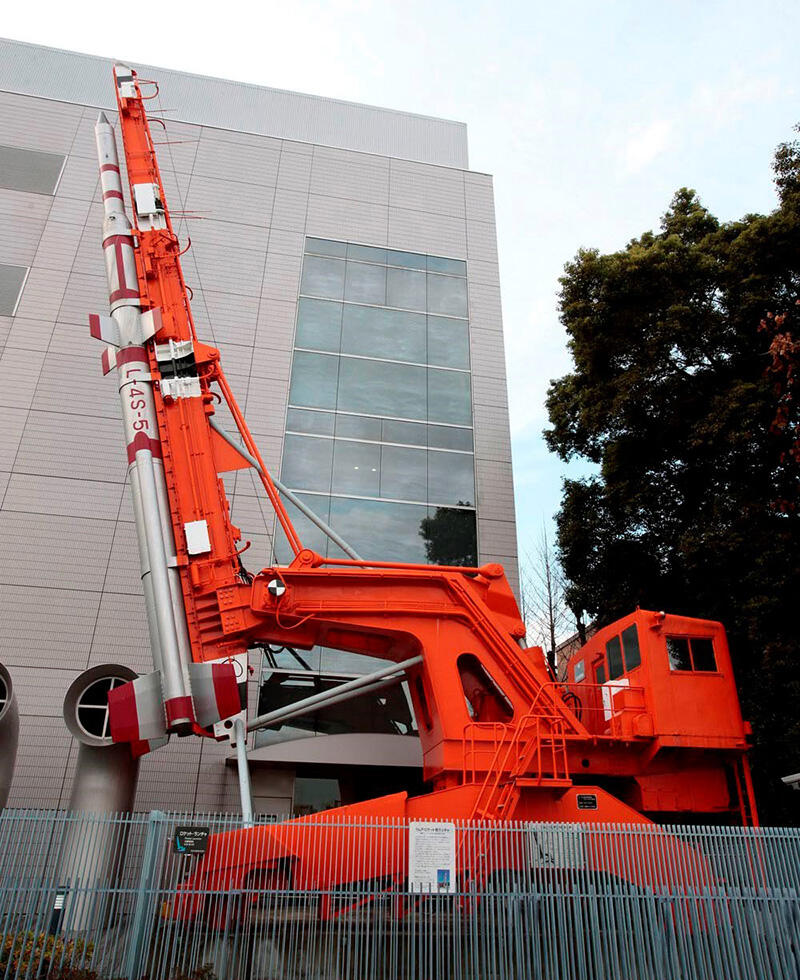
The Lambda rocket launcher that launched Ohsumi as it is displayed today at the Science Museum
Photo: National Museum of Nature and Science
YAMAKAWA
I delivered the opening remarks for the event with a sense of being honored that the symposium could be held in such historic surroundings. Above all, the Science Museum exhibits the actual Pencil rocket that was the first Japanese effort to put a rocket into space, as well as the Ohsumi engineering model and the Lambda rocket launcher to which Ohsumi was attached. The very starting points of Japan's space exploration are all collected at the Science Museum. We were able to hold the symposium with a sort of peace of mind in knowing that this was the case.
HAYASHI
The exhibits have been on loan since the days of the Institute of Space and Aeronautical Science, University of Tokyo, which was the forerunner of the JAXA Institute of Space and Astronautical Science. About 50 years have passed since we first put them on exhibition.
YAMAKAWA
If you look at it from the perspective of "means of transportation," you realize that the rockets that are the means of transportation in space are still in their infancy. Automobiles were born around 250 years ago, railways around 200 and airplanes about 100 years ago.
HAYASHI
Nevertheless, in a period of just 50 years it has become possible, for example, to touch down the Hayabusa2 on the asteroid Ryugu, collect sample and bring it back to the Earth which is quite incredible.
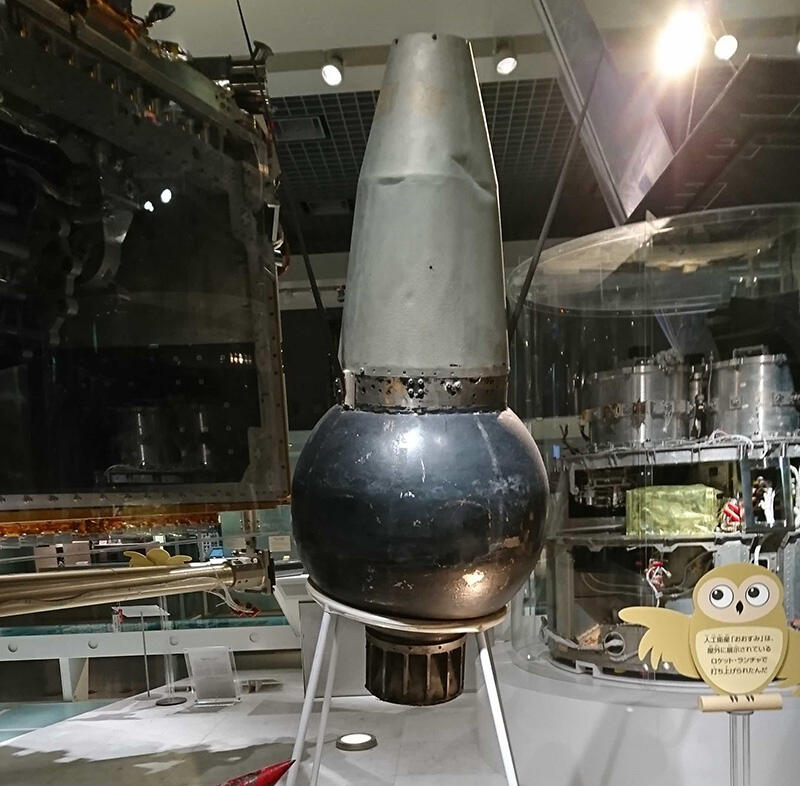
The engineering model of Ohsumi, on exhibition at the Science Museum
Photo: National Museum of Nature and Science
YAMAKAWA
Mentioning Hayabusa2, its predecessor, Hayabusa, was first launched in 2003, and that year was also the year in which Ohsumi, which had been circling Earth since 1970 finally re-entered the atmosphere. From Ohsumi to Hayabusa - I don't mean to treat them as people but you cannot help but think that the "heart" of Ohsumi was passed on to Hayabusa. I was involved as a researcher in the development of Hayabusa, so in that sense it was deeply memorable moment for me.
HAYASHI
I believe that science has to be stringently scientific in every aspect. But as you say about the "heart" of Ohsumi being passed on to Hayabusa I also think that, as you suggest, the story of mankind is inherent in science and through this story I feel the profundity of science, and think it leads to an understanding of science. Currently, there are 5,700 publicly or privately funded museums throughout Japan, and since 2018 the administration of museums that had previously been under the jurisdiction of the Ministry of Education, Culture, Sports, Science and Technology (MEXT) was placed entirely under the Agency for Cultural Affairs. In other words, the science covered by museums is now a form of culture. Looked at from this perspective, I think that focusing on the story-like quality that science possesses is one possible course.
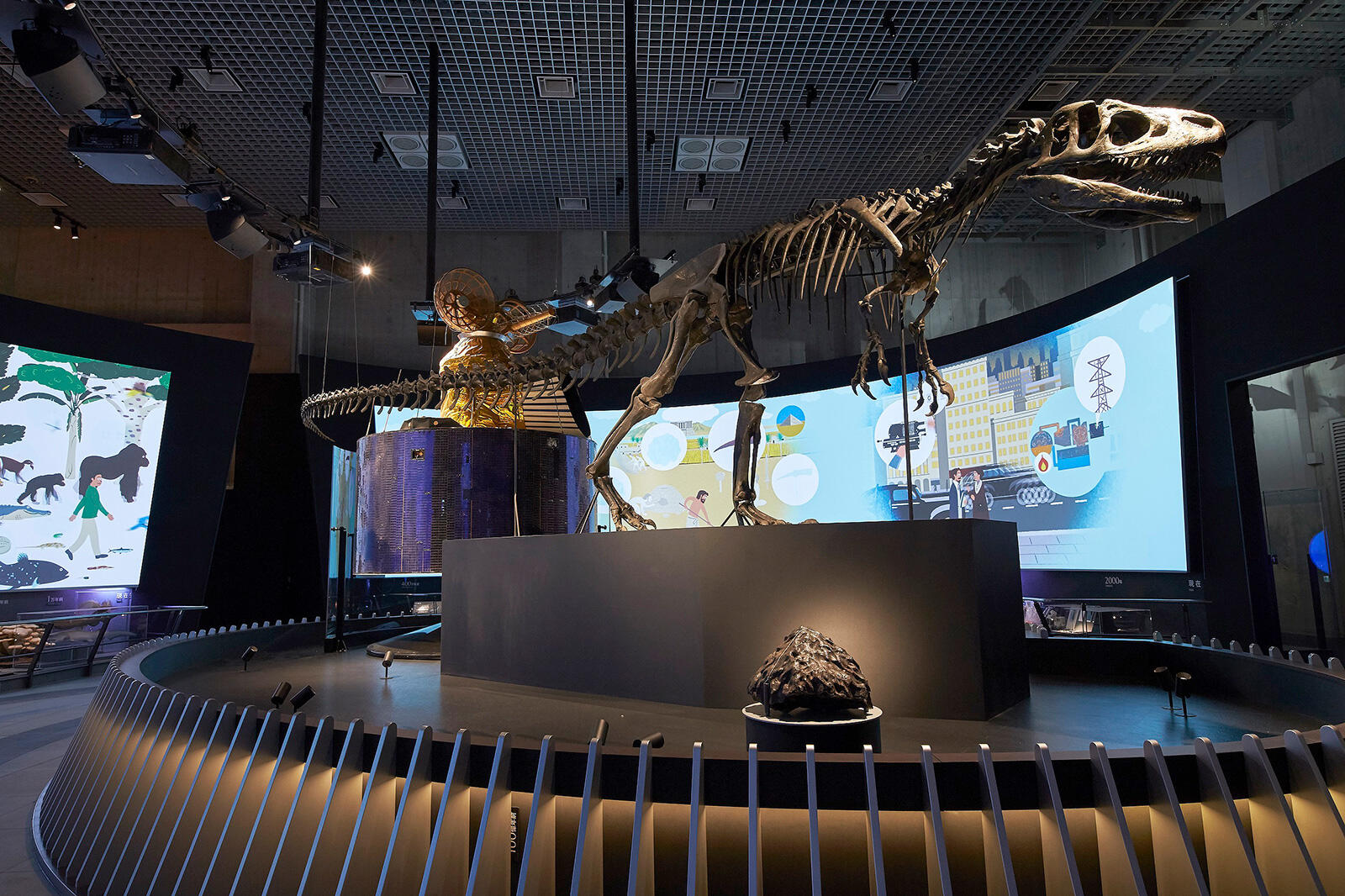
YAMAKAWA
As you say, in terms of its story-like quality space exploration is something with a countless number of tales behind it. At a JAXA symposium held online in November 2020 we filmed and made public interviews with some of the people who had worked on the development of Ohsumi. Among these was, for example, the fact that the first four launches of the L-4S rockets all ended in failure. The fifth launch was finally successful, and some parts of the behind-the-scenes stories looked back on that day on February 11, 1970 when it was Ohsumi that was the very satellite to be sent into orbit around the earth. But it was the local people of the Ohsumi Peninsula who supported its launch and were its greatest backers. It was for this background that Ohsumi, Japan's first satellite, was named after the launch site, and this story is I believe one of the stories essential to the history of Japanese satellites.

HAYASHI
One concrete example from the Science Museum about stories is that on the second floor of the Japan Gallery, among the livestock group that grew in tandem with the Japanese way of life, is displayed the stuffed "faithful dog Hachiko," a famous dog of the Akita breed. Actually until recently we exhibited the faithful dog Hachiko without revealing the story-like quality behind him. This was because we had wanted visitors to look at the stuffed animal from a purely scientific perspective. What I mean by scientific perspective is the point that humans tamed wolves, and after becoming a form of livestock turned into dogs, and eventually produced the Akita breed. We want visitors to properly appreciate that context. It was with this in mind that we tried to avoid drawing attention to the faithful dog Hachiko as a single specific animal, and exhibited him as something that was no more than one element in the livestock group.
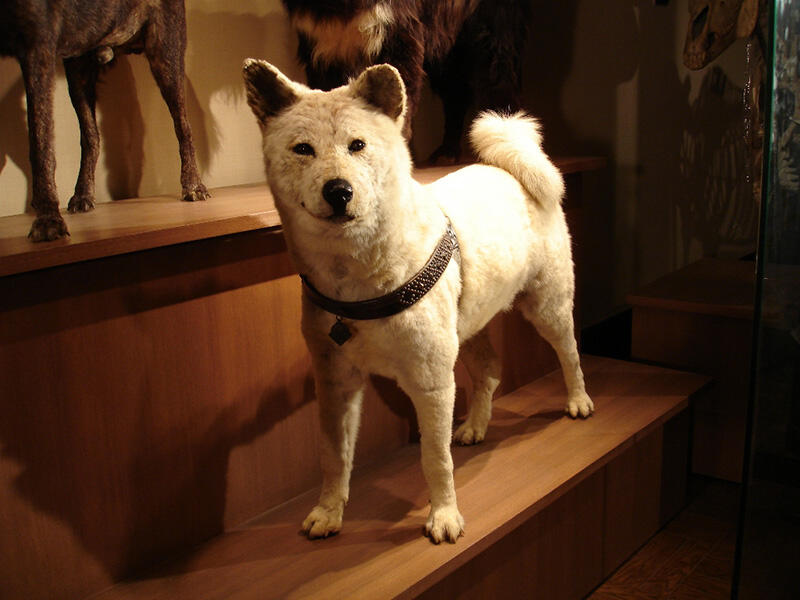
Photo: National Museum of Nature and Science
YAMAKAWA
What was it that led you to conduct the exhibition incorporating the present story-like quality?
HAYASHI
It started with the fact that we received so many inquiries from the visitors to the Museum asking where the faithful dog Hachiko was. Looking at that situation we decided to provide a commentary explaining why it was that the faithful dog Hachiko had earned that name. Since we are a science museum we cannot drop our stance of stringent scientificity, but there is also all sort of fun to be had at the Science Museum. If one way of enjoying this is a story-like quality, we decided that we should adopt it. The story of the faithful dog Hachiko is just one example, and we intend to pursue at our museum diversity as a science museum.
Did the origins of life begin on another astronomical body?
YAMAKAWA
Since you are an expert on biology I'd like to talk about something that will make you feel the connections between life and space exploration. The International Space Station (ISS) that is orbiting Earth at an altitude of around 400 kilometers is manned by astronauts conducting all sorts of experiments, and one of these is known as the Tanpopo Mission experiment or "the astrobiology exposure and micrometeoroid-capture experiments."
HAYASHI
I have looked into the Tanpopo Mission myself. The experiments conducted on KIBO, the Japanese Experiment Module that is part of the ISS, enjoy the participation of a very large number of universities and researchers.
YAMAKAWA
The experiments were conducted mainly by the Tokyo University of Pharmacy and Life Sciences and the JAXA Institute of Space and Astronautical Science, specifically by capturing the fine particles in space around Earth and analyzing them to see if the raw ingredients for life came to Earth from outer space or if, on the other hand, life originating from Earth is floating around in space. Furthermore, scientific investigations have been conducted with regard to whether it is possible for micro-organisms that live in extreme environments on Earth to survive when exposed to an outer space environment.
HAYASHI
I believe that an experimental device was launched from the United States in 2015.
YAMAKAWA
Yes, the device for capturing fine particles is made from a substance called "aerogel," which is an extremely light material similar to a jelly-like substance. The aerogel was installed on the exposed facility of KIBO, and has collected interstellar dust that is thought to contain organic matter such as amino acids and so on floating in space. The device was exposed to outer space for around one year, and was then brought back to Earth on a returning spacecraft. It was then exchanged for a new type of aerogel and the same process was repeated four times up until 2019. The analysis of it is currently underway.
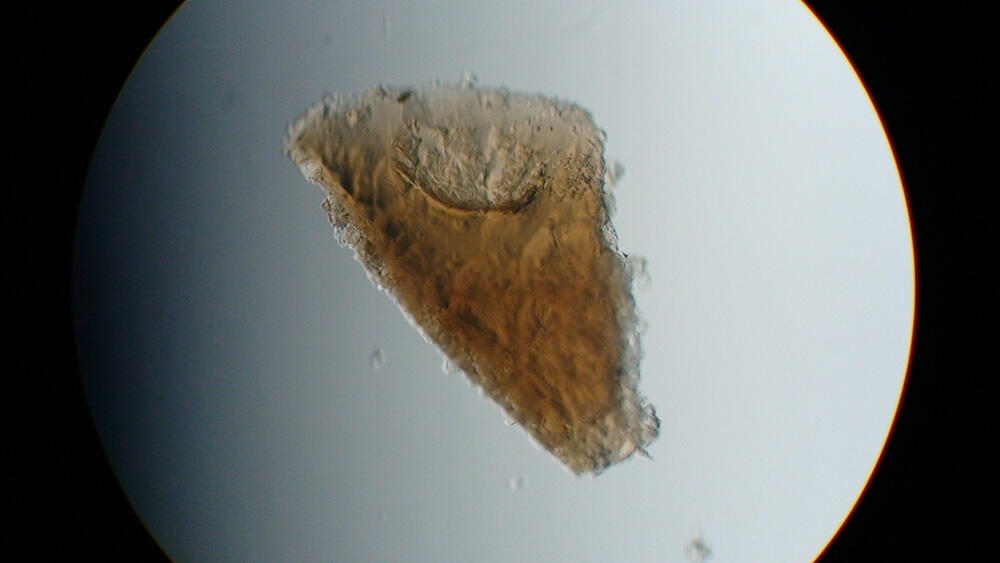
This is a micro-crater with a diameter of less than one millimeter.
HAYASHI
Where and how did the advent of life on Earth, the origin of life itself take place? The theory that life was born on Earth itself is the most persuasive theory, but there is another school of thought called the "Panspermia hypothesis" that suggests that the building blocks forming the origins of life came from another celestial body. As far as I can understand it seems that in recent years the Panspermia hypothesis is being considered more seriously, and I saw the Tanpopo Mission as an attempt to verify various aspects of it through experiments.
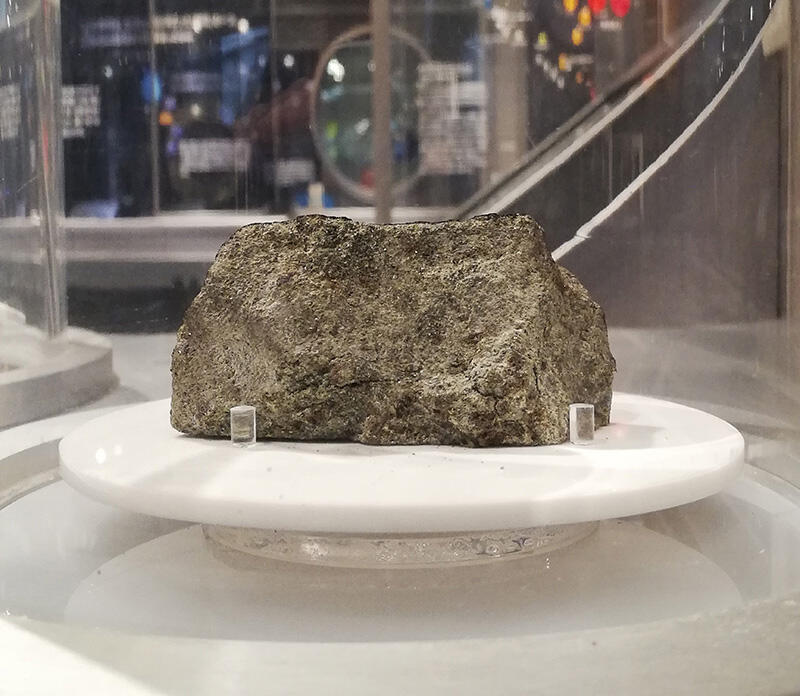
The Nakhla meteorite on exhibition on floor B3 of the Science Museum's Global Gallery. It is six centimeters-long and composed mainly of a greenish mineral called augite.
Photo: National Museum of Nature and Science
YAMAKAWA
You're absolutely right. And if we go beyond the origins of life and talk about things that have come from other celestial bodies, the Science Museum's permanent exhibition includes part of the Nakhla meteorite, which is thought to have come from Mars.
HAYASHI
Yes, the meteorite fell on the Egyptian town of Nakhla in 1911. It is considered that the rocks from which the Nakhla meteorite was produced were the result of volcanic activity on Mars 1.3 billion years ago. A small celestial body crashed into the Martian volcanic zone and the shock caused fragments of stone to be thrown up into space from where, after floating around the solar system for a very long time, they fell to Earth.
YAMAKAWA
This means that there was a movement of substances between Mars and Earth, and I can appreciate there is a fairly high possibility that this is what actually happened. But what about life? When considering that there are perhaps also movements of life, as the Panspermia hypothesis suggests life has moved from Earth to Mars and vice versa via celestial bodies. For example, if celestial bodies collide and the reaction of those collisions cause fine particles to explosively fly off the objects and travel between them, depending on when such events occur there is no doubt that they would have an influence upon life on Earth. Looking at it in this way expands our imagination.
*(The Tanpopo Mission has proved that it is possible for micro-organisms originating on Earth to survive in space for the three years that would be the shortest time span in which they could travel to Mars.)
HAYASHI
The samples collected from the asteroid Ryugu by Hayabusa2 will shortly be returned to Earth [as of the time of the dialog, November 25, 2020], and as it is thought that the surface rock of Ryugu contains abundant organic substances by investigating these samples it may be possible to prove that the substances requisite for the advent of life on Earth were brought to us from outer space.

YAMAKAWA
Indeed, it is thought that Ryugu contains not only organic matter, such compounds including carbon, but also water. These Carbon and water are the most basic elements of life, and its very building blocks. When we talk about these building blocks we are obviously on the path towards the question of the origins of life. So the imminent analysis of the samples from Ryugu is a matter of huge expectations on the part of scientists as it could bring us close to the origins of life, of the solar system, and of the universe itself.
HAYASHI
The Science Museum is both a museum and simultaneously a research institute. We have over 60 researchers each pursuing their own research themes in the fields of natural history and the history of science and technology, so we always think how good it would be if we could collaborate with JAXA in some way, starting with the Ryugu samples.
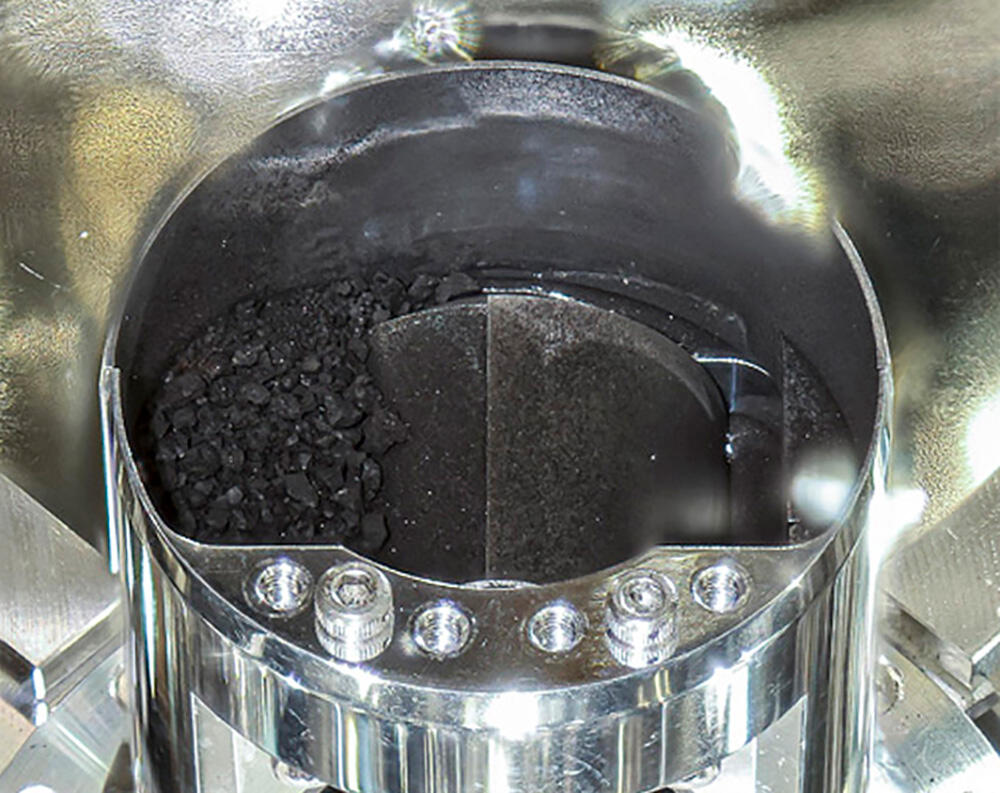
Space engineering and complex biology supported by equations
YAMAKAWA
Some of the irreplaceable disciplines in space engineering, my own area of expertise, are mathematics and physics, and I have liked them since my student days. Why did I like them? If I unravel the reasons for this we go back to the story-like nature that we mentioned earlier. I think one major reason was that I enjoyed reading the biographies of physicists such as Einstein and Newton, which eventually made me aware of the fact that physics and mathematics are very much a human discipline. Furthermore, Newton, for example, is known for discovering the principle of universal gravitation when he watched an apple fall, from which he stated that "force is proportional to the product of masses, and inversely proportional to the square of the distance between them." This is extraordinarily simple principle basically enabled us to express and describe about the movement of objects throughout the world. It enabled calculations and predictions about the future. And with the application of these sort of principles in space science, I as a researcher has been fascinated. So from my point of view the living organisms and life that are your specialization appear to be incredibly complex fields in comparison.
HAYASHI
As you say, I also believe that that is where one of the attractions of science lies. I too have a personal fondness for physics, and up until entering university I must admit I hated biology! [laughs]. Take anatomy for example. There is a name for each and every of the over two hundred muscles, and you have to remember all of them. The etymology of all these muscle names brims over with interesting stories, but having to learn such a vast number of them was not a task suited to my personality. I really felt that strongly. What changed my way of thinking occurred after having entered university. There was still a mountain of things to remember but the depth of my fascination with the diversity of living things exceeded such thoughts.
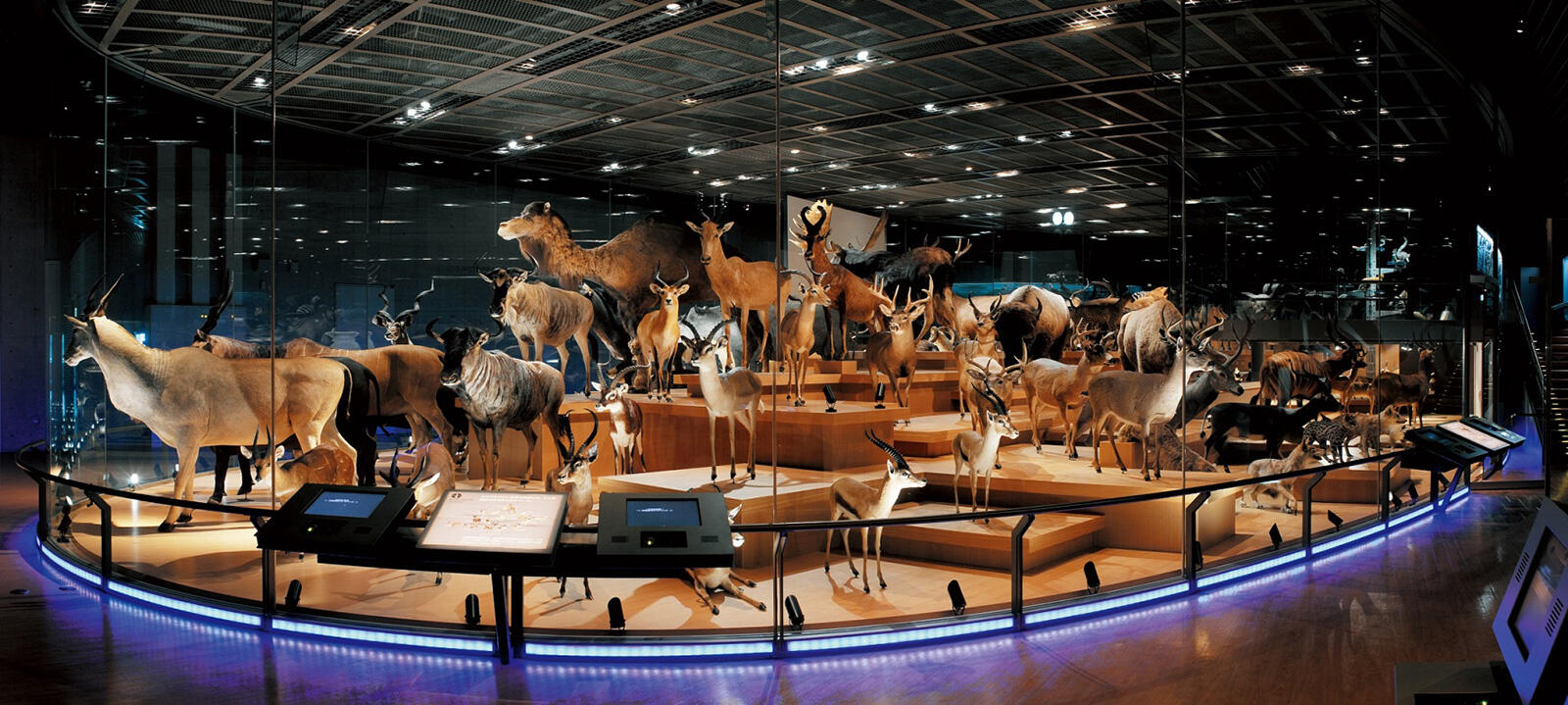
Photo: National Museum of Nature and Science
YAMAKAWA
What was the catalyst that sparked your fascination with the diversity of living things?
HAYASHI
I think a large part of it was the environment in which I was brought up. I was born in Hiroshima but moved to my father's family home in Toyama around the age of two. The house was in an area surrounded by rice paddies, which are a place that it is difficult for children to play in. The one time of the year that I could play there was during winter. Snow fell and froze, and places where I couldn't usually walk became accessible. This is called "climbing on board the sky" in the Toyoma dialect, and I well remember playing in high spirits there. The result of this was that I gained a yearning for places like Hokkaido's pasture land and wanting to rear cows in a places like that became one of the reasons that I attended the school of veterinary medicine in the faculty of agriculture at university. In addition, from an early age I loved and read the works of MIYAZAWA Kenji, the children's story writer and dramatist, and in his writings around 160 species of animals appear. MIYAZAWA Kenji was a writer who thought continuously and profoundly about symbiosis between men and animals, and through his work in due course I too developed an interest in natural history.

Photograph of Jupiter captured by Voyager 1 on February 1, 1979
©NASA
YAMAKAWA
Now that you have explained your background in detail perhaps I can provide a sketch of my own beginnings [laughs]. In 1977 NASA launched the Voyager 1 planetary space probe, and recorded images of celestial objects including Jupiter, Saturn, Uranus and Neptune. These planets displayed a beauty surpassing all mankind's imagination, and on one particular day there was a large photograph of Jupiter taken by Voyager 1 on the front page of the newspapers, with an image of Voyager probe and its orbit on the second page. There was a diagram showing how Voyager 1 had gone into orbit and reached Jupiter. I was a junior high school student at the time, and rather than the beautiful photograph of Jupiter it was the space probe Voyager that captured my imagination. This is so cool, I'd like to try to make one. I thought how I'd like to create my own flight plan too.
HAYASHI
And now you have fulfilled that boyhood dream, haven't you?
YAMAKAWA
Yes, I think that I have been very lucky. And space probes can basically be manifested by Newton's laws, so it's a world that can be calculated. In other words, I became a researcher in the hope that through the world of simple space engineering I could make a contribution to the complex elucidation of life. I think it's possible to put it that way.
Space science to widen humankind's understanding, and space and aviation closely attached to everyday life
HAYASHI
The biggest exhibit at the Science Museum is the YS-11, the one and only domestically produced aircraft.
YAMAKAWA
From the point of view of JAXA as an organization dealing with space and aviation, the YS-11 storage by the Science Museum is something we are extremely grateful for.
HAYASHI
The YS-11 is a propeller plane jointly developed by the public and private sector after the world war, and if you exclude prototypes, is the oldest Japanese airplane. It was maintained and stored by the Science Museum since 1999 at Haneda Airport. In the 2020, in order to enable as many people as possible to view it we moved it to the Hirosawa City theme park in Chikusei City, Ibaraki. The Science Museum stores all sorts of objects including the Mitsubishi A6M "Zero" fighter aircraft, and since an aviation museum has been created at the Hirosawa City theme park we hope in the future to continue exhibiting the aviation technologies in our collection.
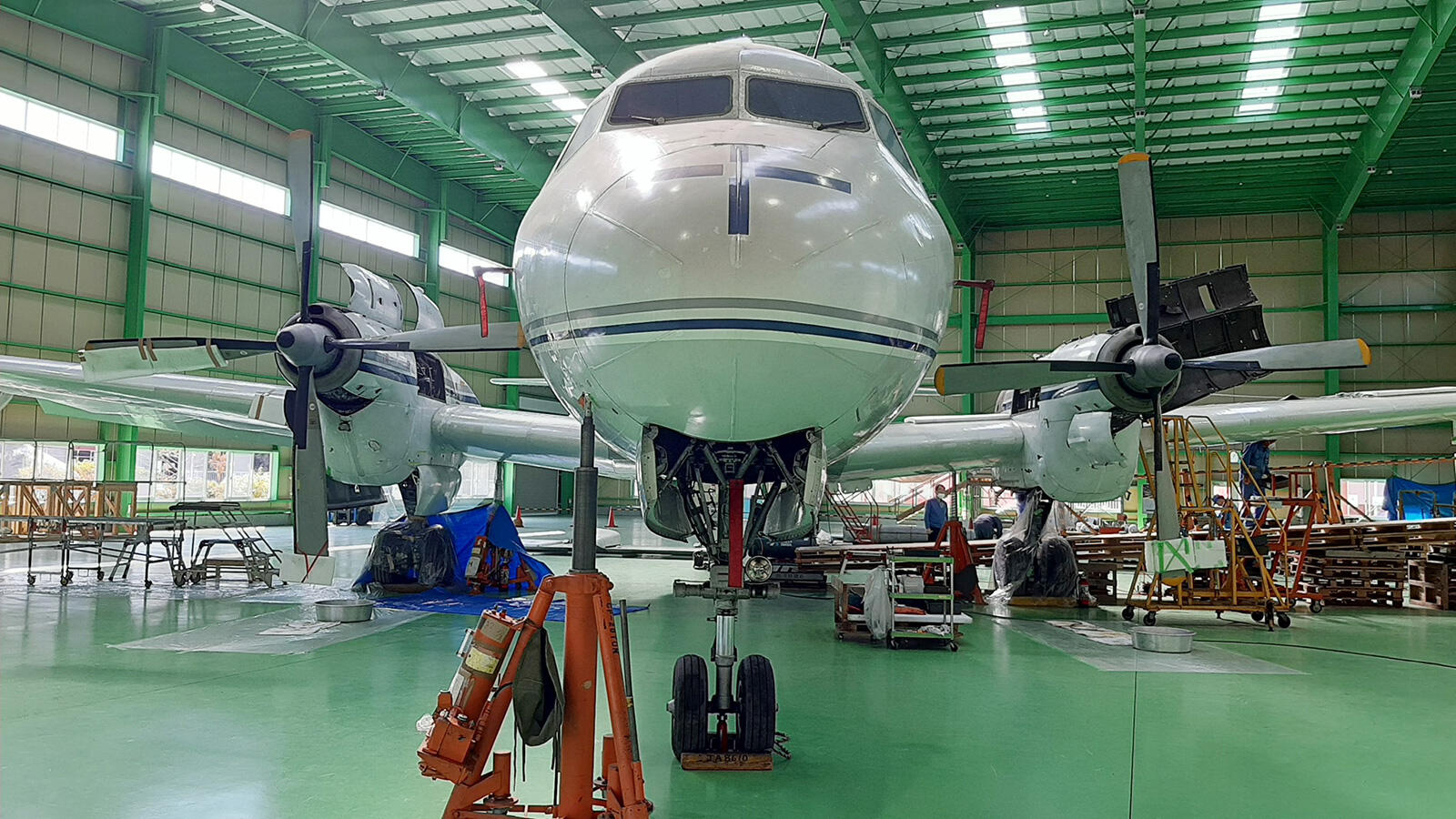
YAMAKAWA
That's certainly something to look forward to. As I said earlier, space engineering is supported by very simple principles, but the aerospace research and development that we carry out at JAXA is extremely multifaceted. For example, the growing issue of climate change by the year. We collect all sorts of data from space and the atmosphere and are pursuing initiatives to contribute to solving this issue, but something I always feel regarding this is that we won't be able to do so from a space and aviation perspective alone. In the final analysis, climate change is also connected to the oceans so unless there is collaboration with other fields of study we won't make progress in the true sense.
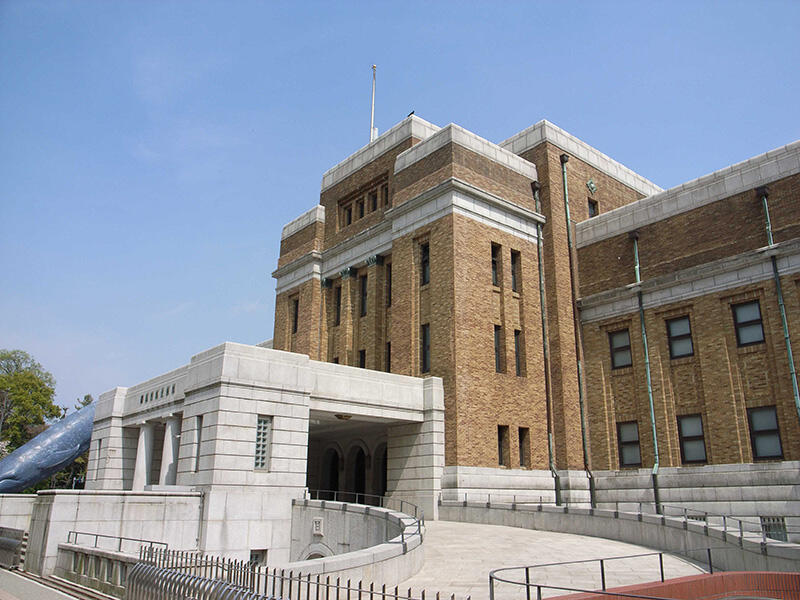
Exterior of the Science Museum
Photo: National Museum of Nature and Science
HAYASHI
I quite agree. This is something that the Science Museum is constantly aware of as a museum dealing with both natural history and the history of science and technology. We are also extremely careful about historical observations at all times. Furthermore, while the Science Museum was originally launched as an "educational museum," it is a case of the visitors themselves studying rather than us educating them. Our stand point is the feeling that we are a place to provide support. This is a process of becoming personally fond of a scientific view of things. Assisting in this through exhibitions and learning support is something that we at the Science Museum intend to involve ourselves in now and in the future.
YAMAKAWA
Carrying on from this, from the point of view of we at JAXA, solving the mysteries of space and life, and the space science and geoscience for widening mankind's knowledge are all important, but at the same time there is the question of what exactly is space and aviation in closely attached term to our daily lives. We want to continue with all sorts of research and development that originates from both of these perspectives.
HAYASHI
Both the Science Museum and JAXA are targeting the whole public, regardless of age or gender. In this sense too, I would be very happy if we can attempt to collaborate with JAXA from all sorts of facets, and be of some assistance to public in deepening knowledge about the planet Earth, life and science and technology.
YAMAKAWA
This would also delight us, and we look forward to working with you.
Profile

HAYASHI Yoshihiro
Director General
Incorporated Administrative Agency, the National Museum of Nature and Science
Born in Hiroshima and brought up in Toyama Prefecture. Became a professor in the Faculty of Agriculture at the University of Tokyo after serving as an honorary member assistant professor at Cornell University. He subsequently held the posts of director general and vice-president of The University Museum, The University of Tokyo. He served as the director general of the Yamashina Institute of Ornithology and as a member of the Science Council of Japan during its 20th and 21st terms before taking up his present post. His hobby is making adventurous trips on his own to the agricultural, mountain and fishing villages of Asia. He is an ardent dog-lover.
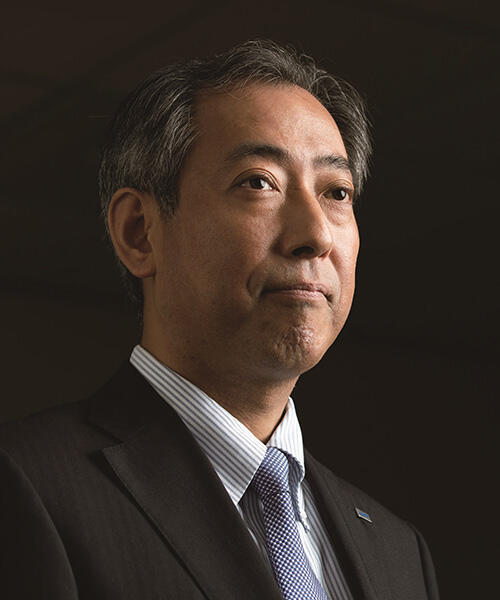
YAMAKAWA Hiroshi
President
Japan Aerospace Exploration Agency (JAXA)
Was involved in the planning of the first Hayabusa mission, and served as the first project manager for the BepiColombo mission to explore the planet Mercury. Subsequently held the posts of professor at the Research Institute for Sustainable Humanosphere, Kyoto University, and Director and Secretariat of the Strategic Headquarters for Space Policy in the Cabinet Secretariat, before taking up his current position. He used to be a devoted mountaineer but now enjoys strolling through towns looking for old things of interest.
All the images are copyrighted ©JAXA unless otherwise noticed.
- Home>
- Global Activity>
- Public Relations>
- JAXA’s>
- JAXA's No.82>
- Special Talk: Stories in Nature and Science and Technology